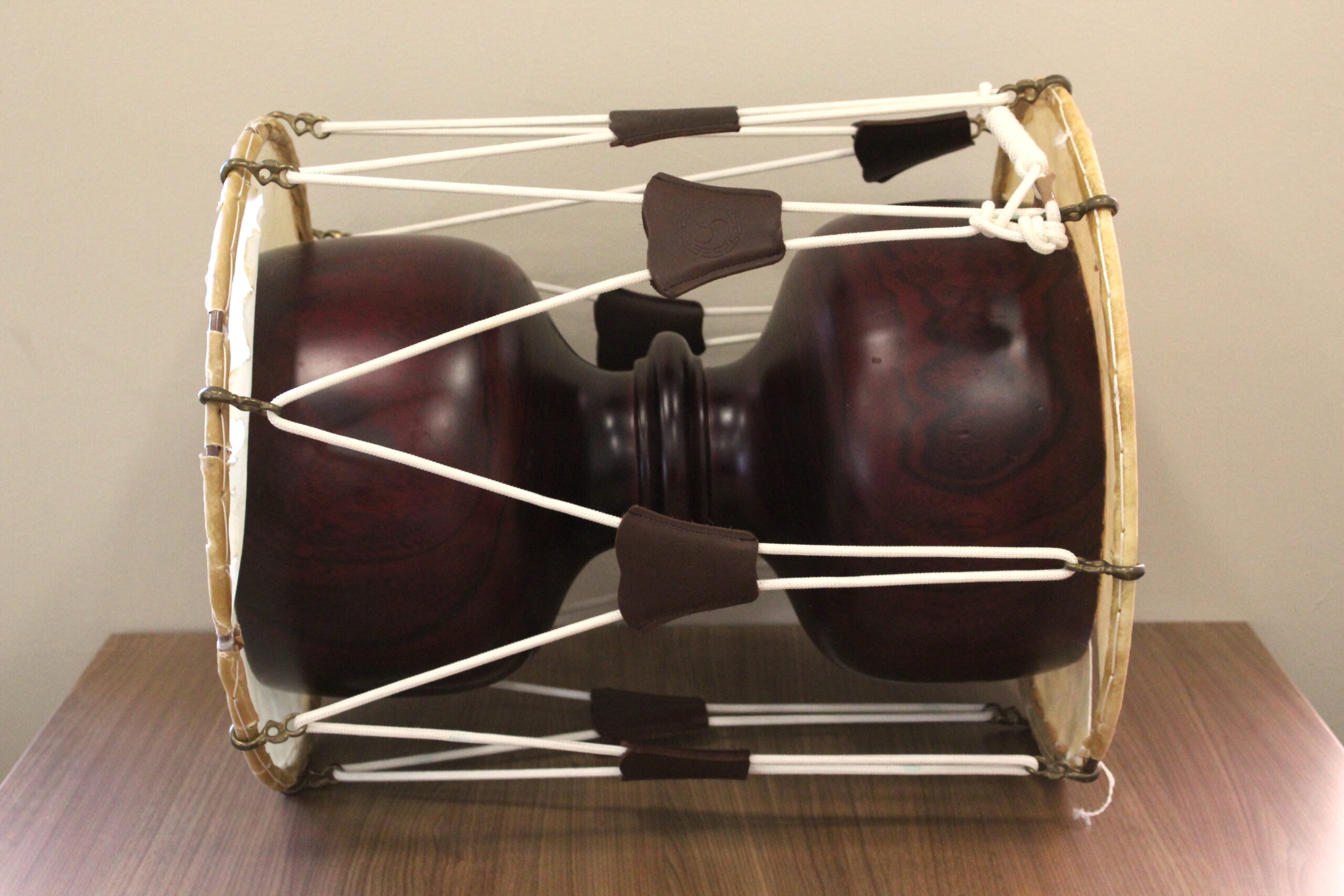About the instrument
The janggo, or janggu in folk styles, is a Korean drum, perhaps the most prominent of Korean percussion instruments. The body is carved into a hollow hourglass shape from a solid piece of paulownia wood, and stretched pieces of animal skin are fastened to metal hoops to form the heads on either side. The ropes that crisscross between the two skins are fitted with leather sleeves that can be used to increase or decrease the tension that holds the two heads securely to the body. To play the janggo, a performer sits cross-legged on the floor behind the instrument or holds the instrument across their body with a shoulder strap. Two different beaters are used to strike the drum on each head: for folk style janggu, players use a bamboo stick and a wooden mallet, while for accompaniment performance a bamboo stick and bare hand are used. The two opposite sides of the drum symbolize complementary qualities: yin and yang, high and low, female and male, ornamentality and stability.

The janggo has a long history in Korean traditional court and folk music, and this style of drum can be traced back to before the eighth century. Wesleyan’ Korean Drumming Ensemble, led by Assistant Professor of Music Jin Hi Kim, plays mostly in the janggu folk style. Professor Kim describes the janggo as the “most essential instrument” of Korean traditional music, which is structured around the drum’s rhythmic cycles. She describes its role in music: “I would compare janggo in the Korean cuisine as kimchi. … In Korea, when you eat food, you must have kimchi. It’s very hot, spicy pickled cabbage. That’s the janggo: you have to have a janggo to make music, to play music.”
Becoming broken: how and why?
The skins have a certain degree of pliability and can withstand pressure from both the stretching of the ropes and the striking of the beaters in performance. However, this capacity for flexibility can change based on environmental conditions. Built in Korea, this janggo is most comfortable in a mild and humid climate. The climate in Middletown, Connecticut, however, is much more variable, and the hot, dry conditions due to indoor heating in the winter are thus an extreme change for the instruments. Under these circumstances, the skins become dry and brittle, causing cracks that can range in size. This janggo has large cracks in the heads on either side of the drum and is the most severely damaged of the broken janggo that I considered for this display.


The wooden body can withstand more fluctuations in humidity and temperature, and the body on this janggo is intact and in good condition.However, they are still fragile and have their material limits. Tightening the ropes too far can cause the drum body to fracture when played, due to increased air pressure from inside the body. Professor Kim emphasizes that drums need to be cared for in similar ways to human bodies: applying too much tension could choke the instrument and in cases of damage, render it voiceless.
Repair or retire?
Skins that are this far broken are completely unusable, at least for the traditional performance that Professor Kim teaches in her Korean Drumming Ensemble. Cracked nearly in half, they will no longer vibrate and produce a resonant sound. If the skin is only slightly torn, it is likely that they will still be suitable for performance, as long as the instrument’s tone is not affected. The skins can also be easily replaced since they are not attached directly to the wooden body. In Korea, this is a common fix, but Professor Kim explains that this option does not work well at Wesleyan: in the process of shipping new skins from Korea, they warp and become misshapen due to extreme changes in humidity and temperature.
Even if a janggo is broken and unusable for acoustic performance, there is still potential for creative recycling of the material. Janggo with cracked skins can still be utilized for creative computer processing and electronic performance, and the wooden body can be repurposed as an umbrella stand or as a coffee table, by adding a flat top. The completely broken skins, however, typically end up in the trash. For Professor Kim, reflecting on the broken janggo is a lesson in the impermanence of things: “I feel very sad about it. But it’s life and death, and I think we just have to deal with this; nothing lasts long forever.” However, she is also enthusiastic about the potential for repurposing the instruments in electronic performance, in a “second generation. Like a star dying, and then there’s a newborn.” Here the janggo can emerge with a new sound in a kind of musical afterlife.
-Devanney Haruta, MA candidate in Ethnomusicology
—–
Click here for a video of the Korean Drumming Ensemble in concert.
Sources
Provine, Robert C. “Changgo.” Grove Music Online. 2001. Accessed 21 March 2021. https://doi-org.ezproxy.wesleyan.edu/10.1093/gmo/9781561592630.article.48362.
Interview with Jin Hi Kim
While Wesleyan’s campus is closed to the general public due to Covid restrictions, we welcome all visitors to explore this virtual exhibit. Please click on the links below to see other posts:


